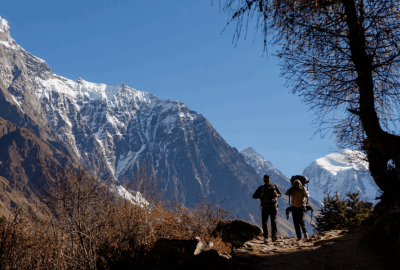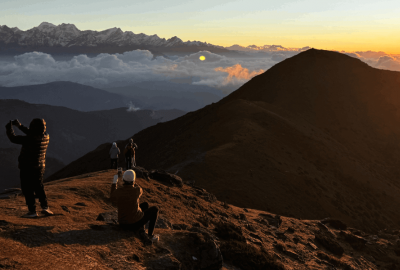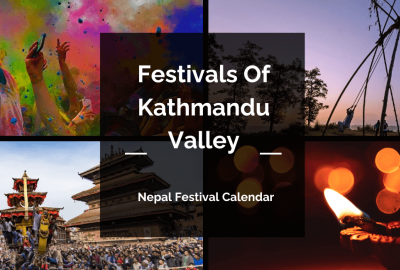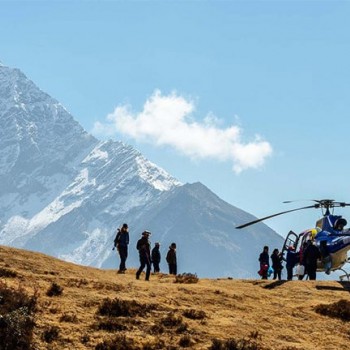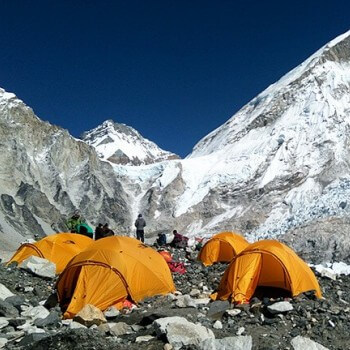Namche Bazaar, located at a height of 3500, is the staging point for expeditions to Everest and other Himalayan peaks. From Tibetan artifacts to trekking and climbing equipment, the small and bright town has everything you would need. Information about various climbs in the area, different mountaineering expedition's memorabilia and information about the Sherpa people's culture and lifestyle can be found in the park headquarters visitor center.
Table of Contents
Plan your trip to Nepal
Customize your trip with help from a local travel specialist.
Popularly known for its cheese and butter, the historic trading center is situated on the slope of an arch-shaped mountain that gives gorgeous views of the giant Himalayan peaks from anywhere in the valley. Traders from Tibet and Sherpas from neighboring villages would once gather to trade goods that displayed alluring traditional arts and crafts. Namche Bazaar was also once the Khumbu region's major trading center. Regardless of its fortune, Namche Bazaar has stayed true to its old traditions, cultures, and hospitality.
The Sherpa dominated settlement is one of the most famous stops along the Everest route. While it does have the usual accommodations, restaurants and equipment stores, you can also find a cyber cafe, pub and a place to play pool here. It is recommended to stay here for a few days so that you can get adjusted to the altitude by walking up and down in the locality. Syangboche or Sherpa villages like Khumjung, Thame, and Khunde are just a few hours walk away from Namche Bazaar and it can help you to get adjusted.
The weekly market fair occurs every Saturday morning in Namche Bazaar and it puts the focus on the middle of the town where the traders are trying to attract potential customers. Namche Bazaar has become a marketplace where trekkers and climbers can do some last-minute shopping.
Things To Do in Namche Bazaar
Trekking in Nepal
Since the 1960s, Nepal has attracted trekkers from all around the world when Col. Jimmy Robert's organized the first commercial trek. Trekking is the sector that brings the most tourists to Nepal with thousands of them going to take on the Himalayas. Everest and Annapurna are the most famous trekking regions while other famous trekking areas are in Langtang and Kanchenjunga regions.
The Great Himalayan Trails is the most challenging one which covers Nepal from the West to Humla to Darchula and Kanchenjunga to the East. 59 meters above sea level in Terai is the lowest point in Nepal while the highest point is 8,848, which is Everest. The two points are only 200 kilometers apart.
Most of the trekkers come to Nepal through the international airport and it is in Kathmandu where trekkers need to acquire their permits and any other relevant documentation. The papers are checked along the trekking route.
The settings of trekking are quite different than what it used to be back in the days. Now there are National Parks and Conservation Areas lodges that have been established in the main trekking areas. The trails are well maintained and are signposted most of the time.
Meet the People
Nepal is an extremely diverse country that is home to multiple races, tribes, cultures, and religions. With over 100 ethnic groups present, Nepal is basically a mixture of languages and ethnicity. While some regions of the country have managed to move along with time, some are still stuck in the past due to inaccessibility. You can see them using mules as a means of transporting goods to and from distant settlements. Oxes are used to plow the fields while blacksmiths make tools. Firewood is also the major source of energy in the villages for cooking.
While city life may look appealing with its light and glory, the traditions and cultures are still practiced the same as they were ages ago. The celebration still carries the same age-old traditions with locals depicting ancient kings who once ruled over their ancestors.
Places to Visit in Namche Bazaar
Tengboche Monastery
With the backdrop of Mt. Ama Dablam, Tengboche is one of the most popular monasteries of Nepal. In the Khumbu region, it is the leading Buddhist Centre with a residing Rinpoche who blesses mountaineers, travelers and pilgrims passing through. A colorful Mani Rimdu festival is celebrated here every October which is a pinnacle of Buddhist celebrations with ritual dances, religious gatherings, and songs. Many trekkers book their trek to correspond with the festival as visitors can partake in it. Every afternoon, the tour of the monastery is conducted for the visitors. Tengboche lies in the famous Everest region trek route.
After Namche, Tengboche is the most well-known night halt on top of a hill across Imja Khola. Across the canyon from Khunde, it is located on a high ridge. While in 1989, the original monastery burnt down, it was rebuilt with a more solid structure. The monastery is surrounded by pine trees, dazzling rhododendrons and azaleas and give a panoramic view of Lhotse, Everest and Ama Dablam. There are numerous accommodations that can be found here.
You can get to Pheriche, the hamlet of Gorak Shep and Kala Pattar from Tengboche. The Everest base camp can be reached easily from here.
Sagarmatha National Park
Home to the highest mountain in the world, in 1976, the area was labeled a national park and it includes several other peaks above 6,000 m. In 1979, it was recognized as a World Heritage Site. It is a rugged terrain made of glaciers, massive rocks, and deep gorges as most of the parks are above 3,000 m. The park has a wide variety of wildlife with more than 118 species of birds. The forest has an abundance of birch, silver fir, rhododendron and juniper trees and animals like the Himalayan tahr, musk deer, the wolf, the Ghoral, the serow, and the Himalayan black bear. The endangered species that can be spotted here are the red panda, snow leopard, and two gorgeous pheasants- the Impeyan and the crimson horned pheasant. Marmots, martens, and pikas are the smaller animals found here.
The altitude in the region ranges in Jiri at less than 2,000 m above sea level and over 8,000 m at the Himalaya. Therefore, the park's flora and fauna are diverse with thick pine, oak forests, and rhododendrons that can be found up to 4,000 m above sea level. March/May and October/November is the best time to visit the park.
Everest Base Camp
Everest Base Camp Trek is quite high in the priority list for trekkers. The starting and ending point of the two-week trek is Lukla which is an airstrip located in the south of the region. Trekkers usually fly to Lukla to begin the trek.
A two days light trek up Dudh Koshi starting from Lukla leads us to the popular Namche Bazaar. Numerous teahouses can be found along the way. On the first day, the popular stopovers are Monjo and Phakding. The entrance to the Sagarmatha National Park beyond Monjo at Jorsale checkpoint where permits are checked. Just a few minutes away from Jorsale you will start going uphill from the suspension bridge and in 3 hours reach Namche Bazaar. It is recommended to stay there for a few days to get used to the change in surroundings.
The trail leads to the valley of Imja Khola after leaving Namche Bazaar which gives gorgeous views of Kangtega, Thamserku and Ama Dablam mountains while the skies are hidden between the Lhotse and Everest. Tengboche is the most well-known rest stop after Namche. The trail then descends through Pangboche until Dingboche or Pheriche is reached.
A 6-hour walk from Pheriche leads to Lobuche which sits on Khumbu glacier's lateral moraine. From Lobuche, it takes 3 hours to get to the Gorak Shep settlement. Accommodations are provided by the few tea houses there. Kala Patthar is located above Gorak Shep which is a good place to take pictures of the mountains. It can take 5 hours to trek along the glacier to reach the base camp. Being cautious is very important as the road is slippery and the risk of falling is there.


